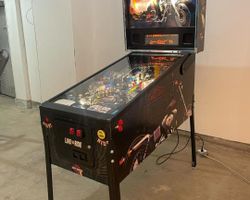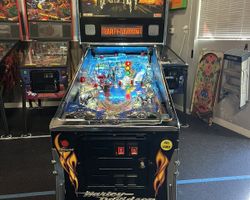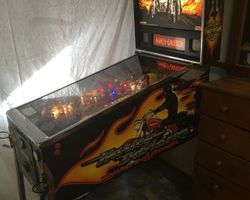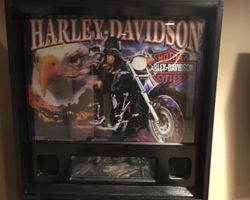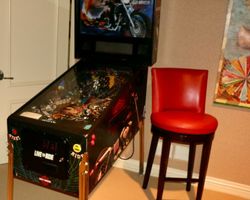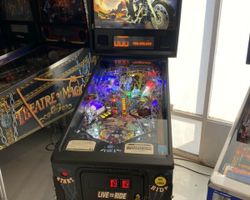Harley-Davidson®
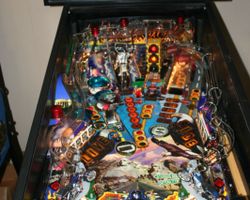
Average Prices: USD $1,700 to $4,800
Produced: 1999
Machine Type: Solid State Electronic
MPU: Sega/Stern Whitestar
Players: 6
Design by: John Borg, Lonnie D. Ropp
Dots/Animation by: Kurt Andersen
Mechanics by: John Borg
Music by: Kyle Johnson
Sound by: Kyle Johnson
Software by: Lonnie D. Ropp
The roar of an engine, the open road, and the thrill of the ride have long captured imaginations, and in October 1999, Stern Pinball, Inc. brought this experience to the silverball world with their Harley-Davidson pinball machine. This release marked a significant moment for the manufacturer as it was the first pinball machine produced under the Stern Pinball name, effectively continuing the production run of Sega's earlier 1999 Harley-Davidson model. It carried the model number 67 from Sega's lineage, highlighting its transitionary status.
The design and production of Harley-Davidson involved a focused team. John Borg, a seasoned pinball designer, took the lead on both the machine's design and mechanical aspects. Lonnie D. Ropp contributed significantly to the design and was also responsible for the software. Kurt Andersen brought the animations to life on the dot matrix display, while Kyle Johnson composed and implemented the sound package, including the machine's licensed music tracks. This collaboration aimed to translate the powerful and enduring imagery of Harley-Davidson motorcycles into an interactive pinball experience. The initial production run of this 1999 model was limited to 600 units, establishing its presence in the market. Its theme, centered around the iconic motorcycle brand, immediately appealed to a broad audience beyond traditional pinball enthusiasts.
Signature Features and Design
Harley-Davidson distinguishes itself with several unique elements designed to immerse players in the motorcycle theme. A prominent feature is the interactive motorcycle toy positioned in the upper playfield. This detailed replica performs a "wheelie," lifting its front wheel to release balls onto the playfield, a dynamic visual and mechanical highlight that integrates directly into gameplay. Complementing this, smaller motorcycle toys are strategically placed near the slingshots, reinforcing the theme throughout the lower playfield. A distinct traffic light mechanism further enhances the visual narrative.
Beyond the visible toys, the machine incorporates a shaker motor, providing haptic feedback that simulates the rumble of a motorcycle engine, particularly during intense gameplay moments like multiball. Another notable feature is an extra button on the cabinet, independent of the flipper buttons, which allows players to raise a center post. This unique mechanic offers a last-ditch effort to save a draining ball, adding a layer of strategic decision-making and a dramatic flourish to close calls. The integration of licensed music, including "Born to be Wild" and "Bad to the Bone," provides an authentic soundtrack that directly links to the Harley-Davidson brand image, enhancing the overall experience.
Playfield and Mechanics
The playfield of Harley-Davidson is laid out to provide a direct and accessible gameplay experience, built around the Sega/Stern Whitestar MPU. It features a single ramp, which serves as a primary shot target for progression. Eight drop targets are integrated into the layout, typically requiring precise shots to complete banks and activate modes. The playfield includes four bumpers, designed to keep the ball active in the upper regions and contribute to scoring. A single magnet is also present, influencing ball movement in specific areas of the playfield.
The design philosophy behind the layout emphasizes a straightforward flow, often directing shots towards the central and lower portions of the playfield. This design choice contributes to a fast-paced game that prioritizes action and immediate gratification. The artwork on the playfield is dedicated to the Harley-Davidson theme, featuring motorcycle models, brand logos, and road trip imagery. While some aspects of the art were later subject to community discussion, the overall aesthetic aims for visual cohesion with the licensed brand. The lighting, using traditional incandescent bulbs, illuminates key shots and playfield elements, guiding the player's focus and indicating active modes or objectives. The prominent "wheelie" motorcycle toy, positioned to release balls, becomes a central visual anchor, reinforcing the machine's primary interactive feature.
Gameplay Dynamics
The gameplay dynamics of Harley-Davidson are heavily centered on initiating and managing multiball modes, which are central to its scoring system and overall progression. The machine features three distinct multiball modes: Harley Multiball, Red Light Multiball, and Speedometer Multiball. These modes are designed to be relatively accessible, often triggered by completing specific drop target banks or hitting particular shots. Harley Multiball, in particular, is known for launching four balls onto the playfield simultaneously, creating immediate high-energy action. This emphasis on frequent multiball sequences contributes to a dynamic and exciting atmosphere, especially for casual players.
Progression in Harley-Davidson involves collecting "patches" and advancing through "cities," leading towards a wizard mode. Players also have the option to select a launch bonus at the start of each ball, choosing between extra points, activating "speed pops" for increased bumper scoring, advancing to the "next city," or collecting a "Harley letter." The machine also includes a video mode, where players control a motorcycle, navigating to avoid oncoming trucks. This mode offers a brief diversion from the main playfield action. While the ruleset is not deep in comparison to some more complex designs, the constant opportunity for high-scoring multiball play and the clear objectives provide a direct and engaging experience. The shaker motor integrates seamlessly, providing physical feedback during these intense, multi-ball moments, further immersing the player.
Reception and Legacy
The reception of Harley-Davidson within the pinball community has been divided. Many players appreciate its accessibility and the sheer volume of multiball action. The frequent activation of multiballs is often cited as a significant strength, making the game entertaining and exciting, especially for those new to pinball or for casual family play. The strong appeal of the Harley-Davidson theme itself, coupled with the authentic licensed music like "Born to be Wild," resonated positively with fans of the brand and those who enjoy a straightforward, high-energy pinball experience. The central wheelie motorcycle toy, the presence of a shaker motor, and the unique center post save button are also frequently highlighted as engaging features.
However, a substantial portion of the pinball community views Harley-Davidson as a machine with a relatively shallow ruleset. Critics often point out that while multiballs are plentiful, they can be too easy to achieve, leading to a perceived lack of challenge and diminishing long-term appeal for experienced players. This simplicity often results in repetitive gameplay, as the objectives beyond triggering multiballs are not seen as sufficiently varied or deep. Some feedback also touches on the artwork, with some players finding it uninspired or a generic application of the theme. The video mode, reused from a prior title, is commonly criticized for being repetitive and lacking originality. Despite these criticisms, Harley-Davidson holds a distinct place in pinball history. It represents Stern Pinball Inc.'s first venture under their own name, albeit as a continuation of an existing design. Its emphasis on approachable multiball action and a popular licensed theme established a blueprint that Stern would refine in subsequent releases. The machine's legacy is that of an accessible, fun pinball experience, particularly for those drawn to its iconic theme and the simple joy of multi-ball frenzy. Its direct, action-oriented design contrasts with more complex, rule-heavy machines, carving out its niche in the vast landscape of pinball machines.
Sponsored Links
 Ebay Listings
Ebay Listings
 Auction Results
Auction Results
| Cost | Location | Date |
|---|---|---|
| USD $4,575 |  Indiana, United States Indiana, United States |
22 December, 2024 |
| USD $5,950 |  Georgia, United States Georgia, United States |
05 December, 2024 |
| USD $4,889 |  Florida, United States Florida, United States |
18 January, 2023 |
| USD $5,800 |  Connecticut, United States Connecticut, United States |
06 September, 2022 |
| AUD $10,000 |  Queensland, Australia Queensland, Australia |
24 December, 2021 |
| USD $4,900 |  California, United States California, United States |
29 April, 2021 |
| EUR €7,800 |  Hessen, Germany Hessen, Germany |
28 March, 2021 |
| USD $5,000 |  Florida, United States Florida, United States |
14 February, 2021 |
| USD $3,600 |  Kansas, United States Kansas, United States |
04 February, 2021 |
| USD $5,999 |  California, United States California, United States |
29 December, 2020 |


Private Policy · Search Website · Contact Us
As an eBay Partner, we may earn a commission from qualifying purchases made through links on this site, at no additional cost to you.
All trademarks and copyrighted materials remain property of their respective owners. All other content copyright 2007 - 2025 Pinpedia.

